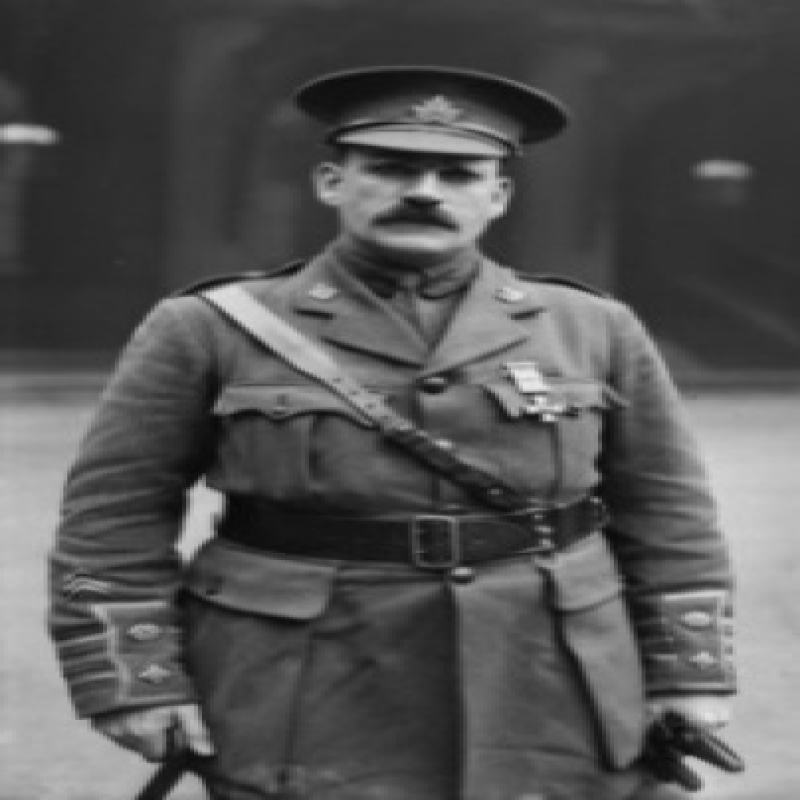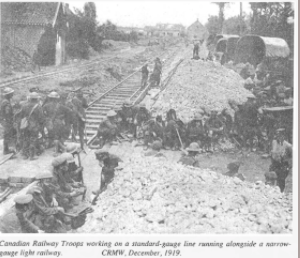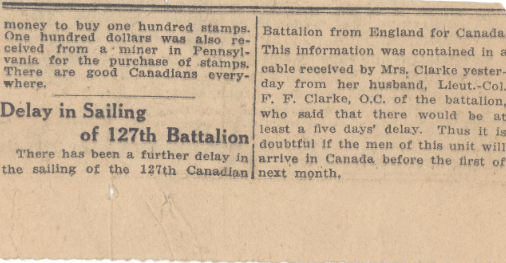
The 127th (12th York Rangers) Battalion, CEF was a unit in the Canadian Expeditionary Force during the First World War. Based in Toronto, Ontario, the unit began recruiting in late 1915 in York County. After sailing to England in August 1916, the battalion was designated the 2nd Battalion, Canadian Railway Troops on November 8, 1916. The 127th (12th York Rangers) Battalion, CEF had one Officer Commanding: Lieut-Col. F. F. Clarke, DSO.
Frederick Fieldhouse Clarke was an engineer and surveyor in northern Ontario. He was born on 22 August 1878 in Hamilton. He served for three years with the Royal Canadian Regiment and nearly twenty with the 12th York Rangers. In January 1916, Clarke was appointed commanding officer of the 127th Battalion of York County.

Canadian Rail, Nov - Dec 1993
According to Fred F. Angus article entitled The Canadian Railway Troops in World War 1, written in Canadian Rail, November-December 1993 issue Angus lists the first five battalions of the Canadian Railway Troops:
"The 1st Canadian Overseas Construction Battalion, which had reached France in October 1916 and was working on Standard gauge railways, became the 1st Battalion, CRT
The 127th Infantry Battalion, then at Bramshott, England, became the2nd Battalion, CRT and proceeded to France on January 11, 1917.
The 239th Battalion became the 3rd Battalion, CRT.
The 4th & 5th Battalions, CRT, were organized at Purfleet, England and were sent to France in February, 1917."
"Things were now moving at ever-increasing speed in anticipation of the campaigns scheduled for 1917. In March, 1917 it was decided to organize five more Battalions of the Canadian Railway Troops, and as more units arrived from Canada they were sent to Purfleet to be organized. By April 1, there were six Battalions in the file, and by the end of June, 1917 all ten were fully operational. So quickly had official thinking turned around that the majority of these units were employed on light railway construction and maintenance and, from mid-1917 until the end of the war, all light railway construction on the British Western Front was carried out by the Canadian Railway Troops."

The following record was published in the The Aurora Banner, April 4th, 1919 upon the return of the 127th Battalion.
"Nearing home is the 127th Battalion - the York County was the foundation unit of the Canadian Railway troops. A part of the battalion was on the "Empress of Britain" under Lieut Col. F. F. Clarke, D.S.O. , and landed Monday and the second party is on the "Coronia" in charge of Major J. H. Holdsworth, second in command.
No body of Canadian troops had a wider or more varied experience in France or Flanders. Col. F.F. Clarke the commander of the unit was in employ of the Canadian Northern Railway before he enlisted and his ability and experience as a surveyor and railway builder were of great value. Many of his men were bright young fellows who had gone into engineering or surveying and there were also a number of students from the School of Practical Science so that the unit was well suited to its work. It was the immobility of the British armies in the Somme fighting of 1916 that gave birth to the Railway Troops. Just about New Year's 1917, the 127th were moved to France and were shoved in on the Somme in front of a piece of line from Commecourt to Grandicourt - a piece of land that had been held by the Hun from the first month of the war. It was on the Ancre River Heights. All efforts to capture it had failed with heavy loses. With the 127th as "army troops" to prepare the way and follow up with materials of war, the British captured the Grandecourt and the Hun began his retreat. It was across this country that the York County unit had to lay the rails that enabled the British forces to crawl steadily ahead and maintain communications with their base. The e127th was in Ypres where they were located from June til Nov 1917. Here they were busy building narrow gauge railway, moving big guns by railway form one point to another running up ammunition and bringing back wounded and they kept at this night and day.
Sixty men of the 127th were gassed around Nieuport on July 19th, 1917, during the famous fighting of the sand dunes when the Germans caught the British on the canal banks. The 127th were putting in narrow gauge railways for the batteries and running tracks up to the front lines when the Germans put on an attack. This was one of the most bitterly fought action sin the sector. The 127th men were caught in the gas waves that came over and the unit had a close squeak from being wiped out.
Earl made several references to the 127th Battalion in his letters home.
October 24, 1916, p.4
"The 500 men are going as a Construction Batt. It is a safe place. And I tried hard to get in it. The work they do is building up bridges, railroads, cutting roads through brushes and hills. They carry no rifle at all just revolver. And they get no pack to carry on their back for half a day. But I guess there is no chance for me to get with them now."
November 18, 1916, p.2
"I told Mother in my last letter that we are leaving for France on the 28th of Nov. I think we will go as a No.2 Construction Batt. So chances are I will get out of being a sniper. Thank God if I do for a sniper has the most dangerous work to do of all."
January 4, 1917, Somewhere in France, p. 3 Earl writes:
"No.1 Construction is about 10 miles from B. Coy, D.Coy is just about 2 mile from them." I have not seen Frank since we left La Harve Station. He is hearing some noise where he is allright. B.Coy expect to move soon. I hear that Mannie Brown of No.1 Construction has been killed. Dada will know him allright. He is a great friend of Billie Ham's. None of the brave 127 lads have been hurt yet. Some have been frightened al little tho. There are lots Ghost over hear in no man's land. Tell Arch the rats are as big as the ones we catch in the creek. I played football with one the other morning down the track. My big boots went pretty good at it. One of the lads in my hut lost 3 hardtack biscuits one night."
March 26, 1917, p.2
"The birds sing every day as tho there is no war at all. Yesterday the shells were singing at us. The 127 lads are hard to hit tho." " I hear from Wallace and Pat & Sid once in a while. Have not seen them yet tho. F.Platt is in D.Coy. I have not seen him for 2 months. F. Young is also in D.Coy."
John Swettenham author of "To Seize the Victory: the Canadian Corps in World War 1" writes on p. 106 of the
'bleak dreariness of trench warfare ... and Blue and white cornflowers, blood-red poppies and yellow cabbage flowers sprang from the lisp of decaying trenches in sickening profusion among the rusty wire. Birds soared in the sky and insects scurried in the dust - while on a plane between the two, man crouched behind sandbagged parapets, bent on his own destruction."
Sept 22, 1917, Belgium - Earl makes reference to some of the 127th lads
"I will tell you their names. (No photo in the letter) Top row left to right - Yek of course you know him. Second is Bill Wellman of Richmond Hill an old 127th Batt lad. Third is Carl Jensin of the 114th Batt. N.B. who was drafted into our Batt in England He is a Dane and a very good Boxer. Second row sitting left to right 1st Frank Wilson of the 112th Batt Nova Scotia he was also drafted into our Batt in England. And the one sitting with the cigarette in his mouth is an old 127th lad Bill Fisher of Richmond Hill. His home is in Ireland. He worked 5 years ago at Badgers place King. They all are coming out to King to see me after the war. Luke and I had our photo taken a couple of wks ago. But have not received them yet. We had these taken in a small town in Belgium. Harold been in it."
October 9th, 1917 letter to Merelda p.3
"Fritzie is sure getting it now. We are winning every day. I see prisoners come down every morning tuff looking nuts to."
March 17, 1918, Cheltenham
"Dear Mother,
p. 2 Merelda asked if Paddy was with our Batt. He is with the 1st C.R.T most of the Aurora Sports are with it too. The Newmarket lads are in D.Coy in our Battalion. But there are not many of the poor chaps left. The old 127 Battalion has lost heavy in France. There are Drafts going across to join us every 3 months."
